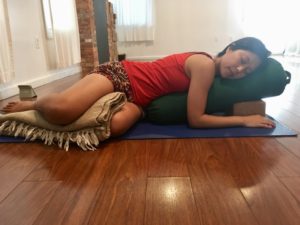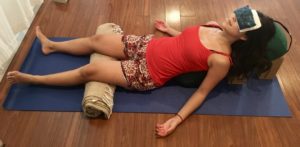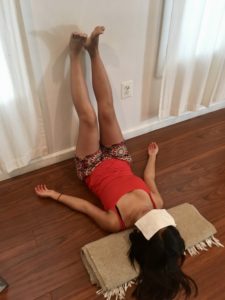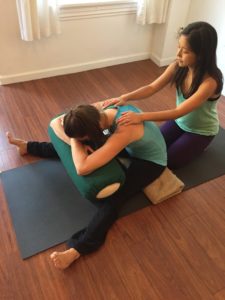
Salamba Bharadvajasana (Supported Spinal Twist)
Embrace the Calm
Deep breath in. Slow sigh out. Body sinks to floor. Mind becomes decluttered.
I attended my first restorative yoga class during a high stress week. This passive practice has become a beautiful counter to my hectic life. Plus in this hot summer it is an excellent way to cool the body down. While it’s not always easy to relax one’s mind and body, the benefits are abundant.
Read on as Christine, a Yoga District teacher, highlights the principles and practices of Restorative Yoga.
If you’re wondering about Restorative Yoga then don’t be afraid to try it. Feel free to attend one of our Restorative Yoga classes or any upcoming workshop.
Origin and Principles of Restorative Yoga

Supported Savasana (Supported Reclining Pose)
Relaxation is the antidote to stress!
Restorative Yoga, also known as the “Rest and Digest”, practice originated from the teachings of B.K.S. Iyengar . It brings deep relaxation and balance to both the mind and body. One of Iyengar’s senior teachers, Judith Lasater popularized Restorative Yoga in the U.S. calls it “an active relaxation.”
The comfort and needs of the individual are met with the use of props to support the body in relaxation poses. Along with the props’ support, Restorative Yoga also uses gravity to assist with relaxation and release of tension. Minimal light to darkness, silence, warmth, and natural or calming breathing are used to reduce excess stimuli and keep the muscles and mind tranquil.
Additional helpful info:

Viparita Karani (Legs Up the Wall)
This is a self-care practice that counters the chronic stress and fast-paced lifestyle of the modern day.
The supported poses and calming breathing provide deep restfulness that nourishes the organ systems of the body and activates the Parasympathetic Nervous System (digestion). This balances our body’s “fight or flight” stress response that comes from the Sympathetic Nervous System.
Restorative Yoga gives time and space for ourselves, allowing us to just be, giving the body a chance to heal itself and the mind a time to settle through relaxation.
Common benefits:
- Relieve effects of chronic stress
- Reduction of blood pressure
- Improves sleep
- Improves digestion
- Reduces muscle tension and general fatigue
Sources and recommended readings:
Restorative Yoga Class

Supta Baddha Konasana (Reclining Butterfly Pose)
Restorative yoga classes are accessible for new and experienced yoga practitioners. They can be adapted for various conditions and injuries. A class typically consists of only a few postures. A little goes a long way!
Classes generally begin with grounding and breathing practices in a seated or reclined restorative pose. Then a slow transitions to each supported pose, held up to 15 minutes.
Props such as blankets, bolsters, blocks, and straps are offered in different variations and can be adjusted in each pose as needed. The purpose is to find a comfortable position with the props. This will allow the body to release on its own with minimal or no effort.
I often tell students, “You are not supposed to feel a stretch, but rather a sigh of release as if you can fall asleep in the pose.”
If you feel a pull or a stretch, the sensation will only intensify countering the active relaxation.
Come explore Restorative Yoga Class at Yoga District by signing up here
A Restorative Yoga Workshop
During a typical Restorative workshop, your body and mind will become cool and at ease. Students will be guided through a series of gentle stretches and comfortable restorative poses. This will be combine with breathing practices, visualization, and meditation. It is designed to lead the body to gently open and release into a deep relaxation.
Join me and you might just fall in love with the Restorative Yoga!


